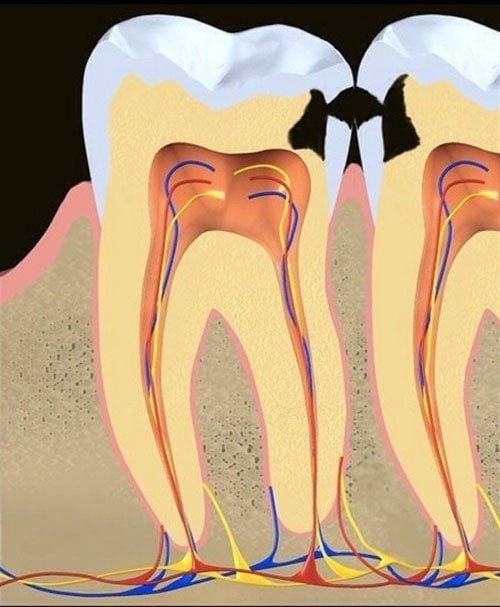
Deep caries
Dentist refer to deep caries as: “caries profunda”. This term defines a certain stage or depth of tooth decay (caries). The end phase of an untreated case of caries is the death of dental pulp. In vernacular speech, dental pulp is also referred to more simply as the nerve. However, before bacteria reach the nerve, they have to eat their way through the different layers of the tooth. To achieve this, bacteria convert sugars into acid. This slowly destroys the hard tooth substances, creating a deep hole. The closer this dental caries comes to the nerve, the more likely you are to experience severe tooth ache as a symptom. What are the layers of the tooth that the bacteria need to work their way through?
1. Tooth enamel
2. Enamel-dentine junction (relevant to treatment)
3. Dentine
4. Pulp (synonyms: nerve, pulpa)
The tooth enamel is the hardest layer of the tooth. It covers the entire outer surface of the tooth, and is what people see when you smile. This layer shines a crystal-white if it is well looked after. It protects the tooth from any and all substances from the outside world that the mouth comes into contact with. Beneath this layer, the significantly softer dentine layer can be found. It is brownish in colour and has small channels that reach down to the nerve. These channels make the tooth sensitive and cause pain when they are exposed. Beneath the dentine, the pulp can be found which contains blood vessels, tissues and the nerves of the tooth.
In summary: Areas of tooth decay that advance through the enamel, the deep layers of dentine, and right up to the area approaching the pulp are termed “caries profunda”.

Filling options with their advantages and disadvantages
If deep caries are not recognised and treated then tooth loss is a real threat. In early stages, the dentist is able to reliably rescue the affected tooth by removing the caries with a drill and closing the tooth using a filling. In the later stages, a special type of treatment is required. The regions immediately surrounding the nerve are treated and covered with special materials and medicines. A conventional filling is then applied on top of this. Here is a list of some options with their advantages and disadvantages:
1. Ceramic inlay, the highest-quality filling: stable, sealed, beautiful.
2. Gold inlay: very durable, sealed, danger of tooth material fracturing, not aesthetically pleasing.
3. Amalgam fillings: form a tight seal, disadvantages include possible intolerance, poor aesthetics and susceptibility to fracture.
4. Composite filling: for the front tooth areas. In the side teeth, however, this filling type often has significant shortcomings.
Dental caries (tooth decay) and how they form
Caries are formed by plaques: a sticky, white biofilm that forms on the tooth surface. This tough substance contains bacteria and nutrients. In terms of which bacteria cause the most damage, Streptococcus Mutans takes the gold. Until the areas in the mouth affected can become pathogenic (i.e. harmful), this biofilm must form for around 24h on the surface of the tooth in specialised layers. If these layers are regularly removed by cleaning away of the plaque, no caries can form. For this to be effective, the biofilm does not necessarily need to be removed 100%. Just disturbing the structure of the film is enough, disrupting the bacterial arrangement. Poor oral hygiene, however, combined with poor diet can lead to severe damage to both teeth and gums. Go to the “gum damage” section to read our articles on inflammation of the gums and periodontal disease.
Our dentists and dental hygienists can help you to recognise hard-to-reach places and give you advice on how to clean in these areas more effectively.
If the pathogenic bacterial arrangement is formed for over a 24h period, the bacteria can finally form organic acids from sugar. In this case, these acids are the cause for loss of tooth material in the enamel, leading to the formation of a hole. The hole in the enamel then serves to provide the caries with additional protection and for that reason must be treated by a dentist before it reaches the nerve. After the caries has been removed, the hole is closed with a sealed filling to keep bacteria out.

Treatment of deep caries
First of all, the areas affected by caries must be reliably identified. White and brownish spots, or even defects on exposed surfaces can be identified with the naked and may give an indication of caries existing. Inflammation of the gums as well as exposed edges from fillings or crowns showing caries can be reliably identified by your dentist. However, the visible tooth surfaces are generally subject to thorough oral hygiene, with patients carefully cleaning these areas. The spaces between the teeth are far more difficult to clean, and as such at much greater risk. The dentist is able to view these in detail using x-ray images.
If a caries is detected, it must be treated depending on its severity. A slight demineralisation can be reversed simply through good care of the teeth and using fluoride preparations. If the enamel is breeched, and the dentine layer is reached, however, this process is not reversible and must be treated by the dentist. Symptoms such as spontaneous bouts of pain or sensitivity to cold in the affected tooth can signal a caries that is already rather advanced.
Using x-ray images and based on clinical information, the dentist can reach a diagnosis and decide on the best course of treatment. To start the treatment of caries, the dentist numbs the region of the tooth with a local anaesthetic.
This ensures that the drilling is pain-free. In cases where deeply-penetrating caries are being treated, an access must be created to allow for viewing of the defect. The access is created by drilling with as minimally invasive an approach as possible. Special drills with slow rotation speeds remove the softened, infected tooth material. This drilling is carried out with the utmost care to ensure that the tooth nerve isn’t unnecessarily opened. On the other hand, it is extremely important to ensure that the tooth is cleared of all decay (caries). In many cases, however, it is inevitable that the tooth nerve is opened in this process. When this happens, an inflammation of the pulp can generally be seen as heavy bleeding.
Once the bleeding stops, or once it can be stemmed, the pulp can be closed up again using the most modern techniques and special materials. The cavity is then closed up with a temporary, but very high-density cement material. Amazingly, if the body’s defences are sufficiently strong, the nerve can patch up the hole that was created in it from the inside If the dental nerve is still alive after several months, a definitive treatment can be planned and carried out.
When are follow-up treatments necessary?
In cases where the nerve dies away, follow-up treatments must be carried. This is because the nerve canal will be flooded with bacteria shortly after the nerve dies, which can cause severe tooth ache. At this stage, many dentists opt for a root-canal treatment, which involves the complete filling of the main tooth canal in the best cases. However, the side canals and numerous areas of porosity are still left plagued with bacteria. Several studies have shown that it is only possible to achieve a reduction in the number of germs through use of files and rinsing solutions. The remaining, and ever-multiplying bacteria must be kept in check by the body’s own self-defence systems over many years. It is not possible to free the patient of this constant bacterial load using this method. Bacteria from amongst this army may even manage to get into the blood stream (bacteraemia) making it easier for a range of different chronic diseases to take hold as a result.
This is why we recommend for our patients to have these teeth removed in a further treatment session, as your health is the real priority. For the reasons set out above, we generally advise against root canal treatments, and consequently, attempting to preserve the dental nerve at all costs is our highest priority. This is due to the fact that a tooth with a regenerated nerve can keep the canal sterile by itself and can therefore be considered to be completely repaired. In cases where this is not possible, the tooth is replaced using either a bridge or an implant. This approach ensures that the underlying tissues are kept free of germs.

“Ceramic inlays are the best filling type for the side teeth, in my opinion. The large chewing forces associated with these teeth can be reliably sustained and a very convincing longevity can be achieved due to unparalleled sealing of the filling border areas. Combined with good oral hygiene, they can last for a life time, just like your unaffected teeth. In terms of their appearance, ceramic inlays are almost impossible to differentiate from tooth enamel with the naked eye. Read our article on ceramic inlays if you would like to find out more.“
Dr. Eva Krapf, Dentist at the Dr. Hager Dental Practice
Avoiding caries
In order to prevent caries, people need to be aware of good dental care practices at home guided by professional instruction and training. In an ideal case, children would be made aware of this from a young age through dental check-up and dental hygienist appointments, acquainting them with thorough oral hygiene practices. Children with good oral hygiene will carry this on into adulthood and will thus dramatically increase their chances of good oral health for their entire lives. We recommend our patients to follow thorough dental care routines using tooth brushes and interdental brushes. To support this, regular professional dental cleaning appointments should also be carried out. This helps to improve cleaning technique and allows for hard-to-reach areas to be cleaned and polished. Tartar and the beginnings of gum inflammation can be reliably detected and treated. Find out more on our dental hygiene website, or give us a call. We would be delighted to help!
The basic cornerstones of good dental hygiene:
1. Healthy diet (maintain breaks between meals. Avoid acidic foods and drinks, as well as snacking)
2. Good cleaning technique with tooth brushes and interdental brushes
3. Regular professional cleaning appointments and regular check-ups
Frequently asked questions
How do I know if I have tooth decay or deep caries?
Areas affected by caries tend to be difficult to identify as they tend to develop in areas that are difficult to see. Even if you can see brownish spots, these are not necessarily tooth decay. Spontaneous tooth ache can be an indication of very advanced caries existing. However, there are many other causes that may be attributed to this kind of pain. A clear diagnosis can generally only be made by a dentist.
Why does tooth ache occur?
Due to the protective layer covering the tooth being penetrated, irritants can be directed towards to pulp of the tooth via small dentine channels. Irritant stimuli can include cold and warm temperatures. Chemical and mechanical stimuli may also, however, cause the pains to appear.
Do fillings or crowns protect the tooth from subsequent bacterial infections?
No, damage may continue to occur on the border areas of any fillings and crowns if oral hygiene is not sufficiently maintained. Damage to the filling material directly, however, is not possible.
Which are the most common sites for dental caries to occur?
Between the teeth, as it is here that only special cleaning tools can clean effectively. For example, dental floss, or better still, interdental brushes.
Which filling type do you recommend for the front teeth, and which do you recommend for the side teeth?
For side teeth, we recommend metal-free ceramic inlays. These can endure high chewing forces and do not change their shape. For that reason, they can maintain a tight seal for a lifetime. In the front teeth, we recommend composite materials. For smaller volumes and areas with reduced chewing forces, composite materials are suitable. Additionally, they can create an aesthetically pleasing finish.